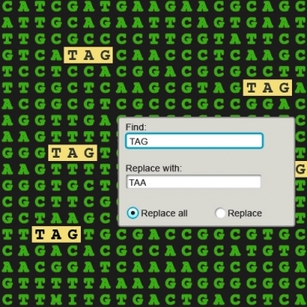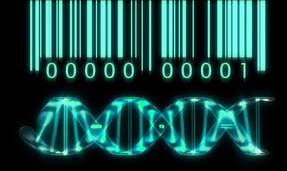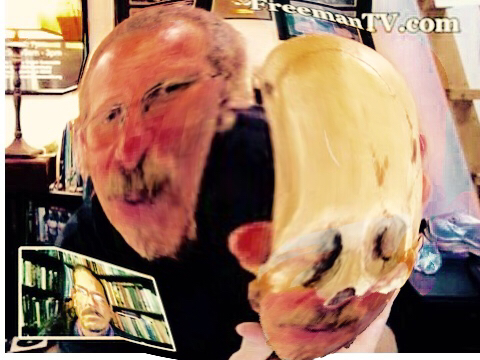Genetic Subversion
| |||||||
The next major explosion is going to be when genetics and computers come together. I'm talking about an organic computer - about biological substances that can function like a semiconductor.
Alvin Toffler
Alvin Toffler
http://www.gmwatch.org/

Our dreams of growing spare human organs in pigs soon to come true


Scientists unveil tools for rewriting the code of life
New technology from MIT and Harvard can edit DNA at the genome scale, giving cells novel functions.
New technology from MIT and Harvard can edit DNA at the genome scale, giving cells novel functions.


Kickstarter crowd gives glowing plant the green light


Woolly mammoth discovery raises exciting possibilities
The recent discovery of a well-preserved woolly mammoth carcass and mammoth blood on a Siberian Island has the potential to "raise the ceiling" on scientific research on extinct species, say Canadian researchers who work with mammoth DNA.
"There's what looks to be fairly well-preserved blood, which leads to the possibility that there's intact blood cells," said Kevin Campbell, a University of Manitoba physiologist who was contacted this week by the Russian researchers who found the mammoth and was asked to collaborate with them.
The researchers from the Research Institute of Applied Ecology of the North at North-Eastern Federal University in Yakutsk, Siberia, are eager to work with Campbell because he has previously used mammoth DNA to get bacteria to generate the mammoth version of hemoglobin — the protein in red blood cells that carries oxygen.
Campbell's study, published in Nature Genetics in 2010, found that the mammoth hemoglobin has adaptations that make it much better at delivering oxygen at cold temperatures than the hemoglobin of the mammoth's close living relatives, elephants. That may have helped mammoths survive the extreme climate of their Arctic environment.
Read more @ http://www.cbc.ca/news/technology/woolly-mammoth-discovery-raises-exciting-possibilities-1.1386398
The recent discovery of a well-preserved woolly mammoth carcass and mammoth blood on a Siberian Island has the potential to "raise the ceiling" on scientific research on extinct species, say Canadian researchers who work with mammoth DNA.
"There's what looks to be fairly well-preserved blood, which leads to the possibility that there's intact blood cells," said Kevin Campbell, a University of Manitoba physiologist who was contacted this week by the Russian researchers who found the mammoth and was asked to collaborate with them.
The researchers from the Research Institute of Applied Ecology of the North at North-Eastern Federal University in Yakutsk, Siberia, are eager to work with Campbell because he has previously used mammoth DNA to get bacteria to generate the mammoth version of hemoglobin — the protein in red blood cells that carries oxygen.
Campbell's study, published in Nature Genetics in 2010, found that the mammoth hemoglobin has adaptations that make it much better at delivering oxygen at cold temperatures than the hemoglobin of the mammoth's close living relatives, elephants. That may have helped mammoths survive the extreme climate of their Arctic environment.
Read more @ http://www.cbc.ca/news/technology/woolly-mammoth-discovery-raises-exciting-possibilities-1.1386398
GMO VIRUSES

Could a Designer Virus Turn You Into a Monster?

Scientists Create Hybrid, Air-Transmissible Bird Flu Strains

The most recent bird flu strain claimed another victim today, bringing the number of dead to 27, all in China. So far 127 people have fallen ill, and world health authorities say the new H7N9 flu is a global threat that should be taken seriously. The strain, which has been transmitted from chickens to humans, is so far unable to move from person to person. But scientists are figuring out how other strains could. The journal Science is publishing two papers today that describe the mechanisms avian flu viruses could use to alter their structure and spread among mammals, including humans. One of the papers studied guinea pigs, which are not necessarily the best way to study the human response to flu—but studies on ferrets, which are a good proxy for people, were halted by a year-long moratorium. That hiatus recently ended, so more papers in this vein are likely to follow.
Read more @ http://www.popsci.com/science/article/2013-05/how-genetic-mixing-and-atomic-shuffling-could-make-bird-flu-more-potent-people
Read more @ http://www.popsci.com/science/article/2013-05/how-genetic-mixing-and-atomic-shuffling-could-make-bird-flu-more-potent-people

Scientists slam 'appalling irresponsibility' of researchers in China who deliberately created new strains of killer flu virus
|
Professor Hualan Chen, director of China’s National Avian Influenza Reference Laboratory at Harbin Veterinary Research Institute, deliberately mixed the H5N1 bird-flu virus, which is highly lethal but not easily transmitted between people, with a 2009 strain of H1N1 flu virus, which is very infectious to humans.The researchers claim the work could help develop a vaccine.'The work of Zhang and colleagues provides a framework for further studies examining how the structure of the avian flu virus influences how readily it could transition to being a pathogen with human pandemic potential,' Science Express, the journal which published the research, said. The study, which was carried out in a laboratory with the second highest security level to prevent accidental escape, resulted in 127 different viral hybrids between H5N1 and H1N1, five of which were able to pass by airborne transmission between laboratory guinea pigs.
Read more: http://www.dailymail.co.uk/sciencetech/article-2318866/Scientists-slam-appalling-irresponsibility-researchers-China-deliberately-created-new-strains-killer-flu-virus.html#ixzz2gDFkywWX |

'Appalling irresponsibility': Senior scientists attack Chinese researchers for creating new strains of influenza virus in veterinary laboratory
GMO FOOD

Meet 'Schmeat': Lab-grown meat hits the grill this month

U.S. investigating rogue GM wheat found in Oregon field

DESIGNER BABIES
Genetically Altered Babies Born |

The world's first genetically modified humans have been created, it was revealed last night. The disclosure that 30 healthy babies were born after a series of experiments in the United States provoked another furious debate about ethics. So far, two of the babies have been tested and have been found to contain genes from three 'parents'. Fifteen of the children were born in the past three years as a result of one experimental programme at the Institute for Reproductive Medicine and Science of St Barnabas in New Jersey. The babies were born to women who had problems conceiving. Extra genes from a
female donor were inserted into their eggs before they were fertilised in an attempt to enable them to conceive.
Read more: http://www.dailymail.co.uk/news/article-43767/Worlds-GM-babies-born.html#ixzz2g2IR5n5q

Report: First Genetically Altered Babies

Creating Babies With DNA From 3 Parents: U.K. May Allow Controversial Technique
LONDON -- Britain may allow a controversial technique to create babies using DNA from three people, a move that would help couples avoid passing on rare genetic diseases, the country's top medical officer says.
The new techniques help women with faulty mitochondria, the energy source in a cell, from passing on to their babies defects that can result in such diseases as muscular dystrophy, epilepsy, heart problems and mental retardation. About one in 200 children is born every year in Britain with a mitochondrial disorder.
For a woman with faulty mitochondria, scientists take only the healthy genetic material from her egg or embryo. They then transfer that into a donor egg or embryo that still has its healthy mitochondria but has had the rest of its key DNA removed. The fertilized embryo is then transferred into the womb of the mother.
Read more @: http://www.huffingtonpost.com/2013/06/28/babies-with-dna-from-3-parents_n_3516000.html
The new techniques help women with faulty mitochondria, the energy source in a cell, from passing on to their babies defects that can result in such diseases as muscular dystrophy, epilepsy, heart problems and mental retardation. About one in 200 children is born every year in Britain with a mitochondrial disorder.
For a woman with faulty mitochondria, scientists take only the healthy genetic material from her egg or embryo. They then transfer that into a donor egg or embryo that still has its healthy mitochondria but has had the rest of its key DNA removed. The fertilized embryo is then transferred into the womb of the mother.
Read more @: http://www.huffingtonpost.com/2013/06/28/babies-with-dna-from-3-parents_n_3516000.html
Click to set custom HTML
|
|
|
Gen-PETS

Pet cloning is the cloning of a pet animal. The first commercially cloned pet was a cat named Little Nicky, produced in 2004 by Genetic Savings & Clone for a north Texas woman for the fee of US$50,000. On May 21, 2008 BioArts International announced a limited commercial dog cloning service through a program it called Best Friends Again. This program came on the announcement of the successful cloning of a family dog Missy, which was widely publicized in the Missyplicity Project. In September 2009 BioArts announced the end of its dog cloning service. In July 2008, the Seoul National University created five clones of a dog named Booger for its Californian owner. The woman paid $50,000 for this service. Science fiction depictions of cloning often create the impression that clones emerge full-grown from machines, are indistinguishable from their predecessors, and have even had their predecessors' minds "downloaded" into them. However, while an animal clone has the same genes as its genetic donor, behavior is influenced by environment and experience as well as by genetics.
Some critics accuse pet cloning proponents of encouraging prospective pet cloning clients to falsely expect that their new pets will be indistinguishable from their old pets. Defenders of pet cloning argue that pet cloning does not contribute to pet homelessness, the animals involved are treated humanely, it makes people happy, there is a demand for it, it will contribute to scientific, veterinary, and medical knowledge, and it will help efforts to preserve endangered cousins of the cat and dog. They also claim that cloning is no more inhumane than breeding. In 2005, California Assembly Member Lloyd Levine
introduced a bill to ban the sale or transfer of pet clones in California. However, it was voted down.
In popular culture
The fictional company Repet clones pets in the movie The 6th Day (2000)
Some critics accuse pet cloning proponents of encouraging prospective pet cloning clients to falsely expect that their new pets will be indistinguishable from their old pets. Defenders of pet cloning argue that pet cloning does not contribute to pet homelessness, the animals involved are treated humanely, it makes people happy, there is a demand for it, it will contribute to scientific, veterinary, and medical knowledge, and it will help efforts to preserve endangered cousins of the cat and dog. They also claim that cloning is no more inhumane than breeding. In 2005, California Assembly Member Lloyd Levine
introduced a bill to ban the sale or transfer of pet clones in California. However, it was voted down.
In popular culture
The fictional company Repet clones pets in the movie The 6th Day (2000)
- Joyce McKinney had her pet dog Booger cloned, as shown in the 2010 documentary Tabloid

The Dark Side of Pet Cloning

Revealed: Ordinary laboratory animals are outnumbered by GM counterparts for first time


Cloned Puppies: Sure, They're Cute, But at What Cost?

When skin cells from a dead pit bull named Booger gave rise to five healthy-looking puppies with a $50,000 price tag, it marked the formal beginning of a commercial dog-cloning industry. But for all the attention given to these and other clones, little was paid to the behind-the-scenes science. For every successfully cloned animal thrust into
the spotlight, how many failures were quietly ushered out of sight? "What we're seeing with the clones they present are the ones that look good," said Jaydee Hanson, an animal-cloning analyst at the Center for Food Safety, a Washington, D.C.-based liberal nonprofit. In March, the U.S. Humane Society and American Anti-Vivisection Society
released a report castigating pet cloning for "serious
animal suffering and disreputable activities."
Read more @ http://www.wired.com/science/discoveries/news/2008/08/dog_cloning?currentPage=all
the spotlight, how many failures were quietly ushered out of sight? "What we're seeing with the clones they present are the ones that look good," said Jaydee Hanson, an animal-cloning analyst at the Center for Food Safety, a Washington, D.C.-based liberal nonprofit. In March, the U.S. Humane Society and American Anti-Vivisection Society
released a report castigating pet cloning for "serious
animal suffering and disreputable activities."
Read more @ http://www.wired.com/science/discoveries/news/2008/08/dog_cloning?currentPage=all


10 Ways Science is Using Human-Animal Hybrids




































































